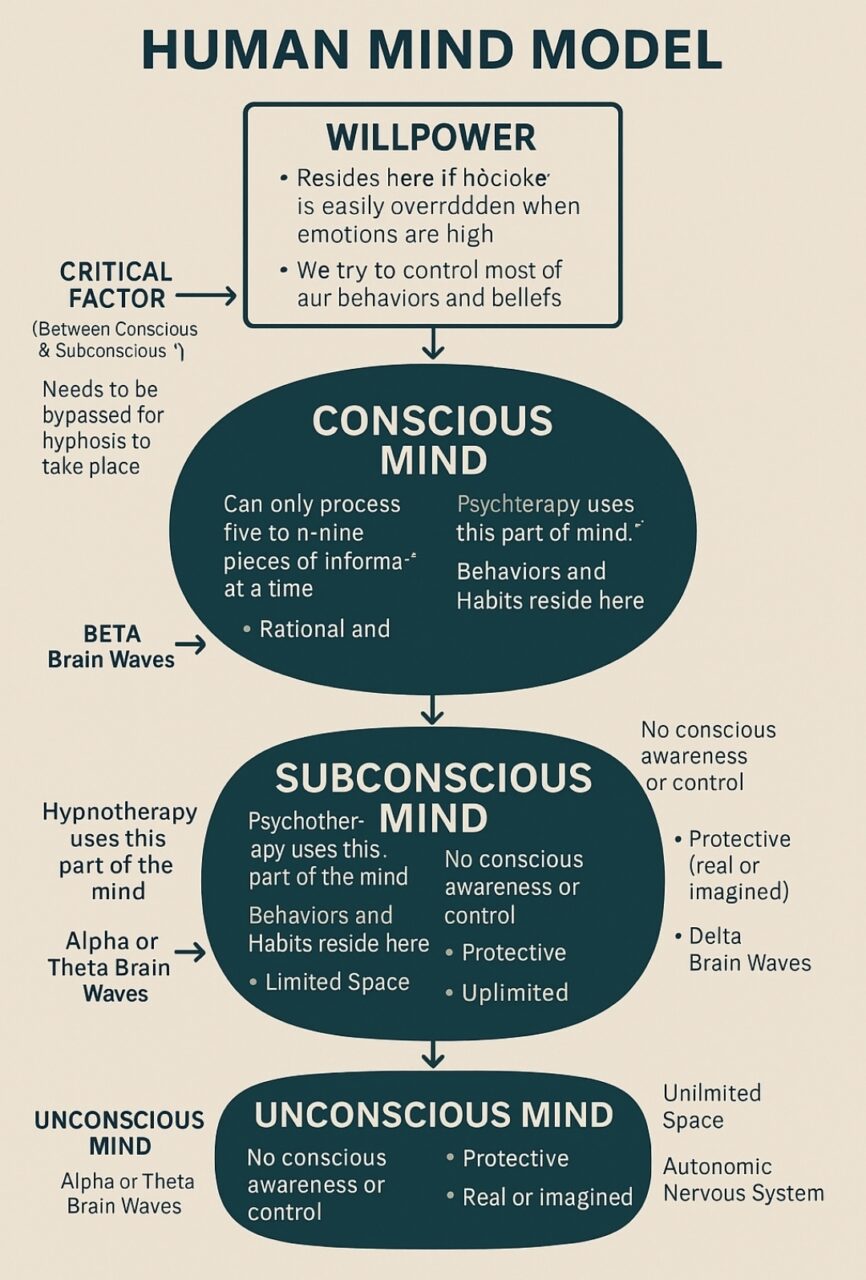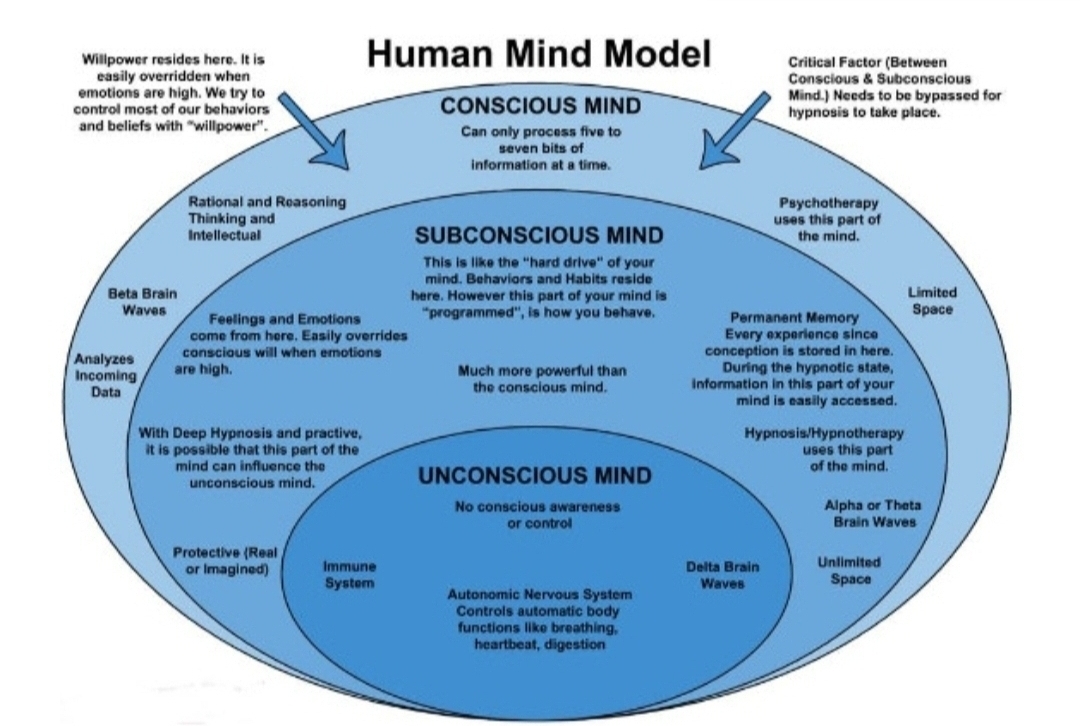The human mind is not a single, uniform “thinking machine.” It is a layered system, with each level serving distinct roles in perception, decision-making, and action. Understanding how these layers interact—and how they can be manipulated—is essential for reclaiming agency over our own thoughts and behaviors.

The Conscious Mind: The Gatekeeper of the Present
- Primary Functions:
- Rational and reasoning thinking
- Intellectual analysis
- Decision-making based on logic
- Processing of about five pieces of information at a time
- Short-term, working memory
- Strengths:
- Allows us to think critically and weigh choices deliberately.
- Provides the initial filter for incoming information.
- Limitations:
- Easily overloaded in high-emotion or high-stress situations.
- Vulnerable to distraction and mental fatigue.
- Influenced heavily by the Critical Factor—a mental gate that prevents or allows suggestions into deeper layers.
The Critical Factor: The Mental Border Checkpoint
- This is the security guard between the conscious and subconscious minds.
- It evaluates incoming ideas: Do they match what I already believe?
- New ideas that conflict with established beliefs are often rejected—unless bypassed.
- Bypassing Methods:
- Hypnosis
- Repetition and emotional arousal
- Media saturation and propaganda
- Trauma and crisis events
This is why both advertising and political manipulation aim to stir strong emotions—once the Critical Factor is bypassed, the subconscious becomes open to new “programming.”
The Subconscious Mind: The Hard Drive of the Self
- Primary Functions:
- Stores permanent memory—every experience since conception.
- Houses habits, behaviors, beliefs, and emotional associations.
- Generates feelings and emotions, which often override conscious willpower.
- Runs on beta brain waves in daily activity, shifting toward alpha/theta in relaxed or hypnotic states.
- Strengths:
- Processes vast amounts of information without effort.
- Holds immense creative and problem-solving potential.
- Vulnerabilities:
- Cannot easily distinguish between reality and imagination—it accepts whatever is vividly and emotionally presented.
- Highly susceptible during states of hypnosis, deep relaxation, or emotional intensity.
This is where psychotherapy and habit change operate, but also where propaganda embeds itself.
The Unconscious Mind: The Hidden Control Center
- Primary Functions:
- No conscious awareness or direct control
- Governs the autonomic nervous system (heartbeat, breathing, digestion)
- Manages protective survival responses (real or imagined threats)
- Regulates immune system
- Operates in delta brain waves during deep sleep
- Strengths:
- Keeps us alive without thought.
- Acts as a protective shield from overwhelming threats.
- Vulnerabilities:
- Can be indirectly influenced through long-term conditioning of the subconscious.
- Fear, trauma, and chronic stress can create maladaptive “protection” patterns—such as phobias or immune suppression.
Why Willpower Alone Often Fails
Willpower lives in the conscious mind—small, rational, and slow. The subconscious and unconscious are massive in comparison, and when emotions run high, they can override conscious intentions.
This explains why people:
- Break diets despite knowing better
- Stay in toxic relationships
- Continue harmful habits “against their own will”
Real change requires reprogramming the subconscious and aligning it with conscious values.

The Double-Edged Sword: Influence and Control
The same mechanisms that allow for personal growth can be hijacked for control:
- Advertising: bypasses the Critical Factor through emotion, repetition, and association
- Propaganda: floods the subconscious with narratives framed as truth
- Education systems: shape baseline beliefs during formative years when the Critical Factor is still developing
Once embedded, these beliefs drive behavior automatically—often without the person realizing they are acting on programming, not independent thought.
Taking Back the Mind
To protect and reclaim mental sovereignty:
- Guard the Critical Factor — Be intentional about what you allow past your mental gate.
- Reprogram with intention — Use repetition, visualization, and emotion to instill positive beliefs.
- Audit subconscious content — Examine long-held assumptions and ask, “Where did I get this belief?”
- Control emotional triggers — Reduce stress and reactivity to keep the conscious mind in charge.
- Feed the mind wisely — Media, conversations, and environments all shape subconscious programming.
Conclusion
The Human Mind Model shows that whoever understands—and can access—the subconscious controls the person. This is why both tyrants and truth-tellers study it. The question isn’t whether the mind will be programmed, but by whom and for what purpose.
If we do not master our own mental layers, someone else will. And history shows—they usually won’t have our best interests in mind.







